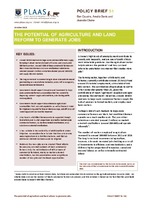| dc.contributor.author | Cousins, Ben | |
| dc.contributor.author | Genis, Amelia | |
| dc.contributor.author | Clarke, Jeanette | |
| dc.date.accessioned | 2019-02-27T11:31:59Z | |
| dc.date.available | 2019-02-27T11:31:59Z | |
| dc.date.issued | 2018 | |
| dc.identifier.citation | Cousins, B. et al. (2018). The potential of agriculture and land reform to generate jobs. Policy Brief 51, Bellville: Institute for Poverty, Land and Agrarian Studies, University of the Western Cape | en_US |
| dc.identifier.uri | http://hdl.handle.net/10566/4305 | |
| dc.description.abstract | Extremely high levels of unemployment contribute to poverty and inequality, and are one of South Africa’s most intractable problems. Can the agricultural sector help to address the problem? And how can land reform be undertaken in a manner that creates more jobs?
The farming sector, together with forestry and fisheries, currently contributes around 2% to GDP and around 5% to total employment, with a total of 840 000 workers. The contribution of agriculture to GDP is in fact somewhat greater than 2%, given the contributions of input (‘upstream’) suppliers and agro-processing (‘downstream’) industries. Around 30 000 medium- to large-scale commercial farmers supply the bulk of produce to formal markets, and employ most farm workers. | en_US |
| dc.language.iso | en | en_US |
| dc.publisher | Institute for Poverty, Land and Agrarian Studies, University of the Western Cape | en_US |
| dc.relation.ispartofseries | Policy Brief;51 | |
| dc.subject | Agriculture | en_US |
| dc.subject | Land reform | en_US |
| dc.subject | Unemployment | en_US |
| dc.subject | South Africa | en_US |
| dc.subject | Farming sector | en_US |
| dc.title | The potential of agriculture and land reform to generate jobs | en_US |
| dc.type | Other | en_US |

